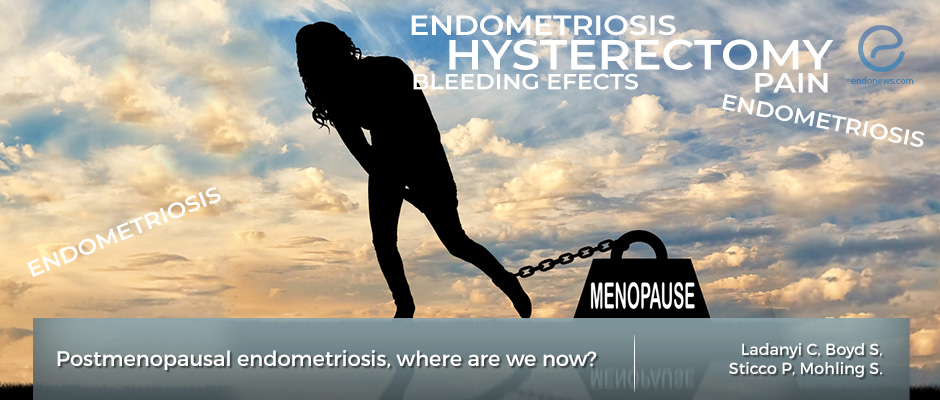What happens to women with endometriosis after menopause?
Aug 22, 2019
Postmenauposal endometriosis, if it exists, has a potential of malignant transformation.
Key Points
Highlights:
- Special attention is required when HRT planned to a postmenopausal patient with endometriosis due to an elevated malignancy risk, even those with a prior hysterectomy.
Importance:
- Swift assessment is essential for postmenopausal patients with complaints of pain and abnormal bleeding.
What's done here:
- This review about postmenopausal endometriosis examines the current literature to help inform the clinical decision-making and to novel approaches for treatment and management.
Key results:
- In the postmenopausal period, some estrogen may still be present either from endogenous or exogenous sources.
- 17 B-hydroxysteroid (HDS17ß) and steroidogenic acute regulatory protein (stAR) which have been demonstrated in endometriotic stromal cells may regulate estrogen production by aromatase in ectopic endometriotic lesions after menopause.
- Once estrogen synthesized it promotes endometriosis through multiple pathways and gives the potential for malignant transformation of endometriotic lesions.
- If HRT needed in the postmenopausal woman with endometriosis, estrogen+progestin combined therapy regimes recommended even the patient has a previous hysterectomy.
Limitations:
- Further researches are needed to understand the true prevalence, cause, and progression of endometriosis in postmenopausal women.
Lay Summary
Endometriosis affects women in their reproductive period of life, with expected regression of lesions in the postmenopausal period. Literature about postmenopausal endometriosis assessing the prevalence, pathogenesis, and treatment is limited. As 2-5 % of postmenopausal women are affected by this uncommon condition, developing stress push forward the necessity for future research on this topic.
Ladanyi et al. from the Department of Obstetrics and Gynecology from the University of Tennessee, USA, reviewed the current literature and recently published their findings regarding postmenopausal endometriosis in the journal "Current Opinion in Obstetrics and Gynecology".
Although no precise explanation for the pathology of endometriosis is made, the main concern of this disorder is estrogen production which is mediated by multiple enzymes with a complex pathway. These enzymes of the estrogenic pathway also found in endometriotic lesions that confirmed the contribution of estrogenic enzymes in its pathophysiology.
Once there is estrogen in the body after menopause, it promotes endometriosis in different pathways like stimulating dorsal root ganglion neurons, to produce chemokines which can activated macrophages.
Estrogens could activate macrophages directly as well, and these macrophages could incorrectly recognize ectopic lesions as injuries which will cause to stimulate neovascularization, increasing the vascular epithelial growth factor and results in the alteration of immune function.
Another explanation for endometriosis in the postmenopausal period is the deeply infiltrating nature of this disease. Surgeons could perform inadequate resection during previous operations that can result in remnant endometrial foci that give a great danger to HRT planned postmenopausal endometriotic women.
Although no studies until today can be able to show the carcinogenic pathway from endometriosis to invasive carcinoma, genetic alterations with mutations in PTEN, TP53, ARIDIA could be the molecular part of this carcinomatous transition.
Postmenauposal endometriosis is uncommon but if it exists, an underlying malignancy should be taken under consideration because it has a potential of malignant transformation.
Clinical symptoms like abnormal bleeding from the vagina, hematuria, rectal bleeding, and hemoptysis accompanying pelvic pain should be carefully evaluated in postmenopausal endometriotic patients.
After confirmation of postmenopausal endometriosis with laboratory and ultrasonographic tests, the primary treatment modality is surgical excision of uterus, fallopian tubes, and ovaries which helps diagnosis besides the treatment. Patients who are not surgical candidates aromatase inhibitors should be the first choice of medical treatment.
Histological data evaluating tissue lesions and peritoneal fluid for estrogen receptors, estrogen metabolizing enzymes, immune cells, and nerve fibers would be the pioneer to evaluate postmenopausal endometriosis in upcoming years.
Research Source: https://www.ncbi.nlm.nih.gov/pubmed/31276453
postmenopause estrogen dependence endogenous and exogenous estrogens aromatase pathways HRT HDS17B stAR malignant transformation endometriosis.

